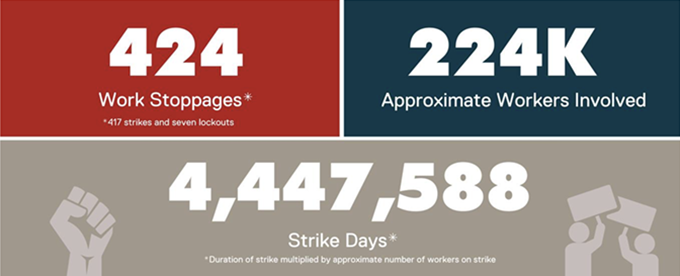Can Labor Seize Its ‘Movement Moment’?

One measure of the labor movement’s relative power is the percentage of the workforce covered by union contracts. From a post-war high in 1955 of 35% in the private sector represented by unions, the percentage has steadily plunged—now to a low of only 6% . That low private sector number is buoyed to just over 10% by the higher percentage of unionized public sector workers.
These dismal membership numbers hide the promise this moment holds for union organizing. Public support, resources, and organizing momentum point to some of the brightest possibilities for the US union movement in decades. Workers around the country stand to benefit most directly—but all who care about preserving democracy have a stake as well.
Support and resources
Public opinion about unions has rarely been more favorable. Polls show that 71% of the public supports unions (the highest it’s been since 1965). The numbers are even higher among young people in their teens and twenties. Such a climate makes this an optimal time to abandon fortress unionism and begin a massive recruitment drive.
The labor movement certainly has the resources and the talent. Today, the financial condition of American unions has never been better. The combined assets of U.S. unions now total $35.8 billion, thanks to real estate holdings and shrewd investment strategies. Put in perspective, labor’s combined assets would rank it as the second largest foundation in the U.S., trailing only the Bill and Melinda Gates Foundation.
Labor’s sizable war chest could be used to help millions of workers organize in manufacturing, logistics, and services where they now work without the benefits of collective bargaining. While most unions don’t disclose their budgets for organizing, the data is very dispiriting for the few that do.
Two unions that propelled organizing in the 1930s, the United Steelworkers (USW) and the United Auto Workers (UAW), devote meager resources to organizing today. In 2020, the UAW allocated only 6% of its budget to organizing, while the USW only earmarked 3% of members’ dues to recruitment. On a slightly more positive note, the International Brotherhood of Teamsters spent 13% of its budget on organizing in 2021. Hopefully that will increase under the new reform leadership. More encouraging is the approach taken by the Service Employees International Union (SEIU), which by its constitution requires locals to spend a minimum of 20% on organizing.
Organizing momentum
Despite the paltry resources dedicated to organizing, there are some very positive signs of labor’s resurgence. In 2022, there were 424 work stoppages that involved approximately 224,000 workers, up from 52 percent in 2021. Also important, the total number of workers involved in work stoppages increased by 60 percent.
Another positive sign: the increase in organizing campaigns to win collective bargaining rights. The National Labor Relations Board (NLRB) reported that it supervised 1,714 representation elections in 2022, a 52.4 percent increase from 2021. Workers voted in favor of unionizing in 72 percent of those elections, up from 61 percent in 2021.
Much of the increase in union elections was driven by organizing among baristas at Starbucks. Starbucks has 9,000 retail locations in the US, and over 293 outlets have voted in elections supervised by the NLRB to join Starbucks Workers United, an affiliate of SEIU.
While Starbucks workers do not occupy a classical “strategic” position in the economy (although overpriced Starbucks coffees do fuel worker productivity or lack thereof), their campaign has captured the imagination of the American public and has energized a whole generation of labor activists.
The leader of the first Starbucks organizing victory in Buffalo, New York in 2021 was Jaz Brisack, a Rhodes Scholar turned barista. Now she is using her organizing talents to assist workers forming a union at a Tesla factory in Buffalo. The hope is that like Ms. Brisack, many of these young activist workers will carry their experience into other sectors of the working class.
A strike by 48,000 University of California teaching assistants and graduate researchers paralyzed the state’s higher education system and led to dramatic gains for these campus workers who are united in the UAW. Important campus organizing by adjunct faculty, graduate students, and resident assistants is occurring on many other campuses as well.
The new organizing outside of the UAW’s traditional base in auto manufacturing is having a major internal impact on the union. UAW members recently concluded an historic internal election after years of “one party” rule. The reform movement that successfully pushed for a referendum to win direct, one-member, one-vote election of top officers recently swept a majority of seats on the executive board and elected a reform leader, Shawn Fain, as president. Now these reformers will take the reins of the union going into negotiations with the big three: Stelantis (formerly Chrysler), General Motors, and Ford, where contracts expire on September 14.
The presence of a large number of graduate-level education workers in the UAW was undoubtedly one factor that led to the reform of this once powerful union. Today, there are approximately 1.3 million workers in auto assembly and auto parts but fewer than 300,000 are members of the UAW. Ironically, the large presence of campus workers in the UAW may enable a new and more vigorous organizing capacity that the union desperately needs to focus on organizing in the auto industry once again.
Bringing the fight to Amazon
One of the most important current organizing campaigns is by workers at Amazon. The company now employs more than one million workers in the U.S., with about 850,000 of those employees in warehousing.
Amazonians United is organizing in New York City, Philadelphia, and elsewhere to build power in warehouses using a combination of solidarity and NLRA Section 7 rights. The independent Amazon Labor Union won a union election victory in April 2022 at a warehouse on Staten Island that energized the labor world. And organizing by Amazon workers continues to spread. Amazon workers are forming unions with RWDSU—a division of the United Food and Commercial Workers (UFCW)—in Bessemer, AL, and with the American Postal Workers Union in several northern cities. No other union is facing more of a threat from Amazon’s low-road employment standards to the wages and working conditions that it has achieved for its members than the International Brotherhood of Teamsters. As the largest “logistics” union, it has made a major commitment to building organizing committees at multiple Amazon locations.
In addition to helping workers at Amazon build power, the Teamsters union is engaged in a huge contract campaign for its 340,000 members at UPS whose collective bargaining agreement expires on August 1. Teamster leaders are waging an aggressive campaign to win significant contract improvements and eliminate a two-tier wage system. This crucial battle will hopefully inspire more Amazon workers to see the benefits of collective bargaining and rise up and organize.
One final bright spot on the American labor scene is an active reform movement growing within UFCW. While the union has a substantial presence in grocery and retail, it has not been up to taking on the challenge of organizing at Wal-Mart or newly emerging grocery stores like Whole Foods. The movement, dubbed Essential Workers for Democracy, will be organizing at this year’s convention to elect new leadership and make major changes to the union’s constitution. If the reformers are successful, it could lead to another major advancement in growing a more democratic and militant union movement.
The increase in strikes and organizing by a restless working class and the renewed membership energy stemming from several vigorous reform movements are hopeful signs. However, the great paradox remains that even as public opinion is swinging in favor of unions and activity is increasing, labor leadership is not devoting sufficient resources to seize this “movement moment.”
However, if we agree that a revived labor movement—and more worker organizing—is essential for any hope of combating the rise of the far right or tackling pernicious economic inequality, then we can’t wait for the union treasuries to open. It’s imperative to unite as much of the labor movement as possible with a far broader Left to defend our entire democracy.
That challenge has never been more urgent or relevant than today. In 2020 and then again in 2022 several unions set a shining example by deploying labor “ballot brigades” in battleground states. They partnered with community organizations like LUCHA in Arizona or electoral action groups like Seed the Vote to make a key difference in states that Democrats carried by very slim margins.
Think of 2024 as labor’s Bella Ciao moment, akin to when left Italian partisans fought the Fascists, often in an alliance with broader popular forces. Their united front stood them well in postwar Italy and enhanced their political credibility.
If the MAGA forces try to steal the election again in 2024, labor must be ready to engage in dramatic direct action. But first we must regroup again in another broad united front to win the election—or the far right will have nothing to “steal.” Bella Ciao, Bella Ciao!
The Stansbury Forum is happy to be co-publisihing this article with Convergence
Rand Wilson has worked as a union organizer and labor communicator for more than forty years, most recently as Chief of Staff for SEIU Local 888 in Boston. Wilson was the founding director of Massachusetts Jobs with Justice. In 2016 he helped to co-found Labor for Bernie and was elected as a Sanders delegate to the Democratic National Convention. He is an elected member of Somerville's Ward 6 Democratic Committee. Wilson is board chair for the ICA Group and the Fund for Jobs Worth Owning. He also serves as a trustee for the Somerville Job Creation and Retention Trust.
Peter Olney is retired Organizing Director of the ILWU. He has been a labor organizer for 50 years working for multiple unions before landing at the ILWU in 1997. For three years he was the Associate Director of the Institute for Labor and Employment at the University of California. With co-editor Glenn Perušek they have edited Labor Power and Strategy by John Womack Jr and available now from PM Press.

